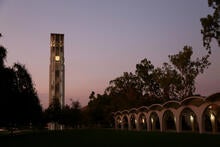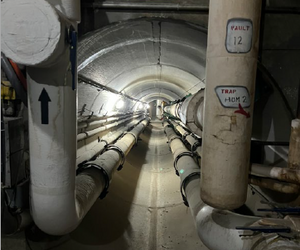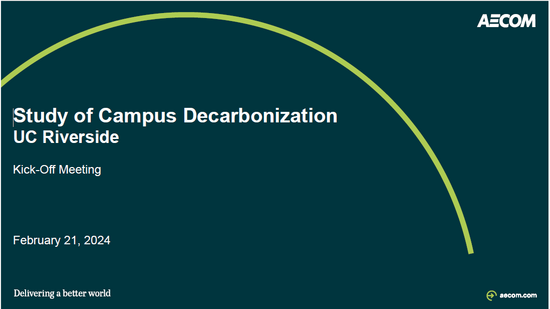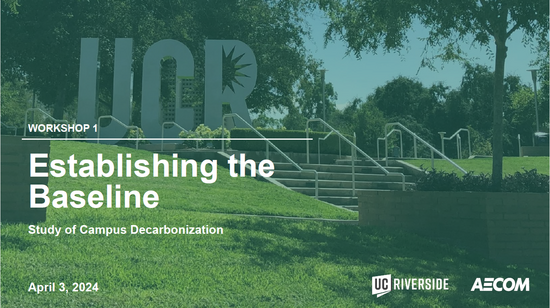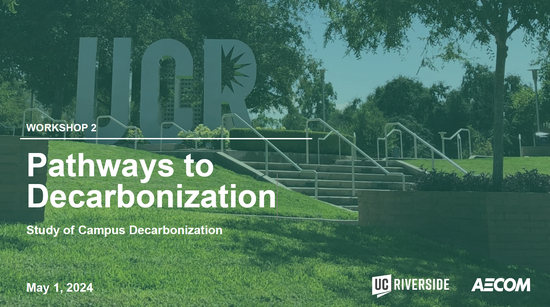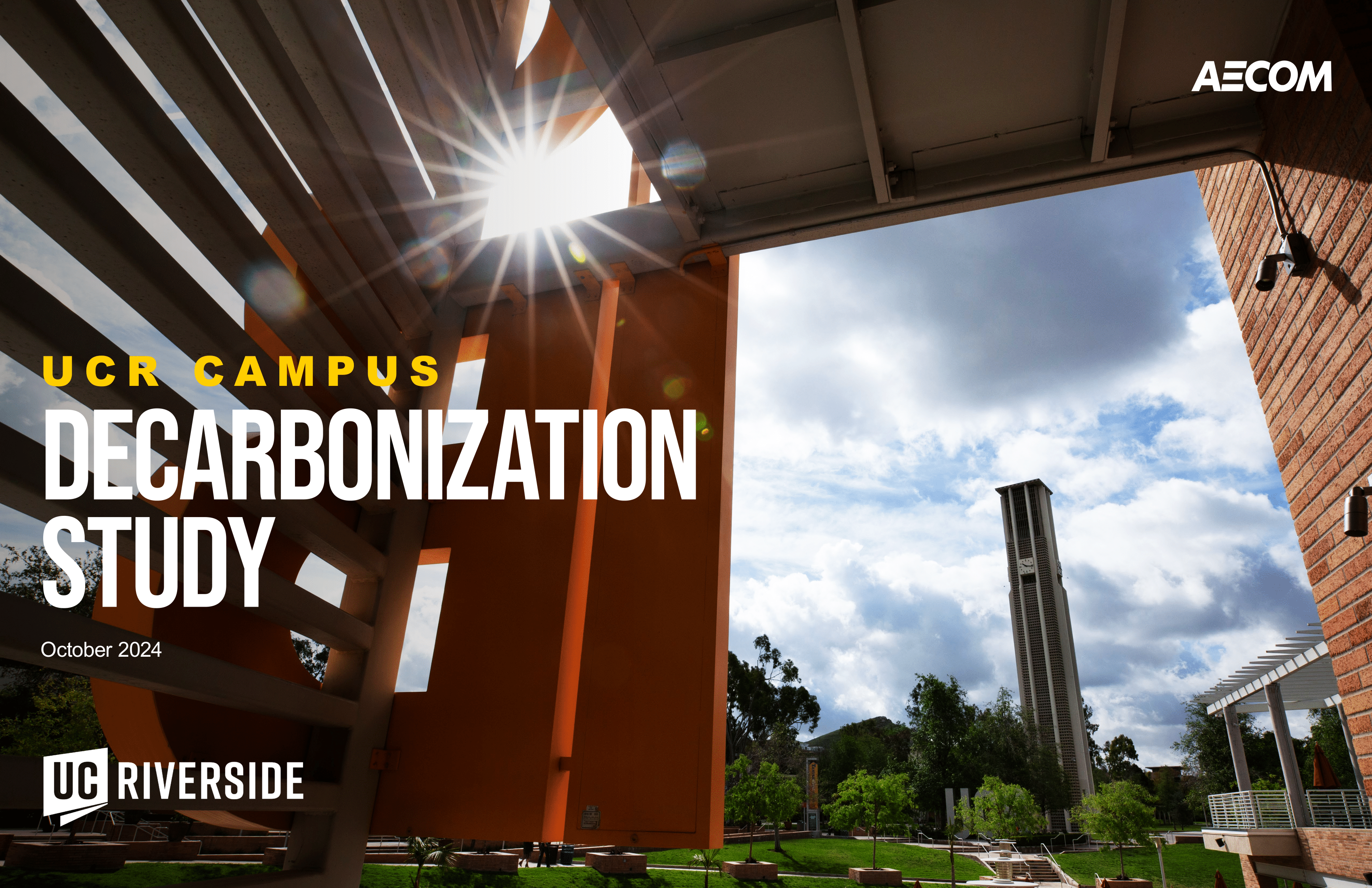Office of Sustainability

UCR Campus Decarbonization Study
PROJECT BACKGROUND
In 2013, the University of California announced an ambitious goal to become carbon neutral by 2025. But as the deadline approached, deep decarbonization became difficult and the UC system opted for some solutions that were not scalable by broader society (renewable natural gas) or where the real benefits were questionable (carbon offsets). Because of these concerns, activists called upon the UC to fund a path toward true, scalable decarbonization.
The UC addressed these concerns with a new strategy that delayed the deadline for carbon neutrality to 2045, but is attempting to truly decarbonize with real, scalable reductions of scope 1 emissions (direct greenhouse (GHG) emissions from sources controlled or owned by the campus; from combustion of natural gas
UCR's electric utility, Riverside Public Utilities, is rapidly decreasing the emissions associated with its electricity as it replaces its coal-fired generation with wind, geothermal, and solar. By 2027, its emissions intensity will decrease by nearly 2/3 from its 2022 numbers. With electricity on a clear path towards decarbonization, the next step is to create a plan for reducing emissions from on-campus combustion.
PROJECT DESCRIPTION
UC Riverside’s Central Utility Plant (CUP) produces chilled water, steam, compressed air, and vacuum air. A second satellite Plant, only produces chilled water. These utilities are distributed to campus buildings utilizing a piping network mostly located in underground tunnels with some direct buried pipe. Three chilled water energy storage tanks totaling almost 7 million gallons are used to supply campus with chilled water during peak electricity demand time periods. Chilled water is produced during off-peak hours to replenish the tanks.
Steam is produced continuously via combustion of natural gas in four steam boilers. The Steam Plant can produce up to 150,000 pounds per hour (lbs/hr) of steam that is distributed to the majority of the Academic Center buildings for HVAC, domestic and process heating water; science research, teaching laboratories; and on-campus restaurant kitchens. A handful of campus buildings are equipped with their own natural gas fired boilers.
Steam generation accounts for 80-90% of the University’s Scope 1 emissions. This project will study and develop a strategy to reduce these campus Scope 1 emissions by 90 percent. Replacement and/or retrofit options for the existing steam plant including the associated underground tunnel distribution piping and appurtenances will set the foundation for UC Riverside to achieve carbon neutrality. Fleet vehicles, Housing HVAC boilers and dining hall kitchens account for the remaining campus emissions.
PROJECT LOCATION
This study encompasses the systems and equipment supporting the entire campus. The Central Utility Plant, Satellite Plant, Electrical Substation, Housing, Transportation Services, Agriculture, etc., all have a role in UC Riverside’s effort to reduce carbon emissions.
Campus Decarbonization Study Deliverables
-
Deliverable #1
Produce a strategy for a 90% or greater reduction in Scope 1 emissions from fossil gas use in campus energy systems from a 2019 baseline. The strategy will provide decision support for campus leadership to commit to the earliest possible target date for full direct decarbonization and interim targets for the central energy systems, while maintaining resilience, electrical reliability, and regulatory compliance. Multiple scenarios (reflective of timing, fuel switching, etc.) are encouraged to provide richer decision support to leadership and to allow for flexibility. Scenarios should include evaluation of what would be required to achieve electrification of main campus energy systems at the location. Additionally, scenarios may consider the role of biogas and/or green hydrogen for remaining systems that are not fully electrified. To align with proposed UC policy goals, the strategy should include interim Scope 1 greenhouse gas reduction targets and dates.
-
Deliverable #2
Provide high level estimates of total capital and operational costs and savings, by phase if relevant, in sufficient detail to support funding requests to government and donors as well as inclusion in the campus or health system’s capital financial plan. This cost-benefit analysis should include high level estimates of avoided maintenance, renewal, biogas, carbon offsets, water, and the social cost of carbon.
-
Deliverable #3
Identify climate justice and equity considerations related to the transition of campus energy systems to fossil fuel free and propose solutions or next steps to identify solutions. These considerations reference the UC Framework for Incorporating Environmental and Climate Justice into Climate Action and should:
- Assess the vulnerability of labor and surrounding community to transition to fossil free.
- Develop and evaluate equity indicators on transition impacts and opportunities.
- Incorporate four (4) major climate and environmental justice concepts:
- Procedural: fairness of the decision-making process.
- Recognition: respecting different values, cultures, opinions, and structures within communities.
- Distributive: just allocation of resources, benefits, and burdens.
- Restorative: responsive to those impacted by the transition.
-
Deliverable #4
Document knowledge gaps, and subsequent studies and analyses needed to conduct Net-Zero planning that addresses the following:
- Interim reduction targets and dates covering all applicable Scope 1, 2, and 3 emissions.
- All fossil fuel uses.
- A comprehensive institutional boundary.
- Climate and environmental justice.
- Risk minimization (financial, operational, and reputational).
-
Deliverable #5
Document knowledge gaps, and subsequent analyses and engagement activities needed to conduct climate action and resiliency planning for an academic setting, inclusive of:
- Living laboratory opportunities for research demonstrations, courses, or student projects, or other involvement.
- Service activities and scalable, replicable knowledge sharing.
- Resiliency within a community context and framed within a climate and environmental justice lens.
- See Deliverable #3 and University of California - A Framework for Incorporating Environmental & Climate Justice into Climate Action
- Biodiversity and habitat protection.
